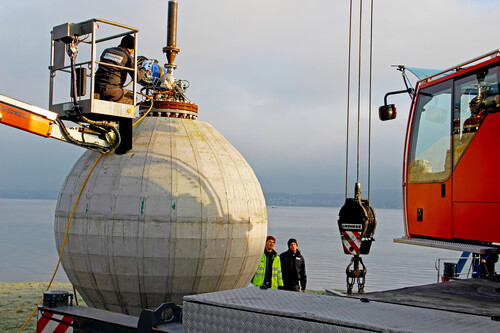While France and Germany strengthen their energy alliances with a renewed commitment to nuclear power, Germany is also developing an entirely different system. This time, the focus is on the deep sea to redefine how renewable energy is stored.
Under the sea. A group of researchers at the Fraunhofer Institute in Germany created the Stored Energy at Sea (StEnSea) project. Since 2011, the team has worked on reducing land use and concluded that giant concrete spheres should be sunk into the seabed for energy storage.
How it works. The spheres sit at depths between 1,968 and 2,624 feet, where high water pressure efficiently drives turbines. Each sphere measures about 30 feet in diameter and weighs roughly 400 tons. They function as giant batteries. Seawater flows in and spins a turbine connected to a generator. Then, energy from the grid pumps water back out to recharge the system and counter the ambient pressure.
 Future application of a StEnSea plant.
Future application of a StEnSea plant.
A real-world test. Experts have already tested StEnSea successfully in Lake Constance. The next step is set for 2026, when the team plans to install a full-scale, 3D-printed prototype off the coast of Long Beach, California. This model will generate around 0.5 megawatts and store up to 0.4 megawatt-hours—enough to power an average U.S. household for about two weeks.
Their plans are ambitious: to build much larger spheres, up to 99 feet in diameter, that can store significantly more energy. According to the researchers, the estimated storage cost is about five cents per kilowatt-hour—a competitive rate compared to other current solutions.
Renewables in Germany. Though Germany’s climate may seem ill-suited to solar energy, the country has invested heavily in it, particularly for self-consumption. Still, it faces a major challenge: intermittent production, or Dunkelflaute. Projects like StEnSea can serve as a buffer for the electricity system by storing excess renewable energy and releasing it when needed.
But what about hydroelectric power? Unlike traditional pumped storage, which requires mountains and large reserves of fresh water, this system needs no elevation or limited water resources. Its modular design allows for installation on coastlines worldwide. The system also offers an economic edge by enabling energy arbitrage—buying electricity when it’s cheap and selling it during peak demand.
Forecasts. Researchers believe this technology has only revealed the tip of the iceberg. They estimate that if deployed at scale, it could reach a global storage capacity of about 817,000 gigawatt-hours—enough to supply around 75 million homes annually. However, while the project aims to reduce land use, it shifts that occupation to the seabed. So far, developers have focused on technical feasibility. Future phases should include rigorous environmental assessments to examine its impact on ocean ecosystems.
Image | Fraunhofer Institute
Related | Texas Wants to Force Solar Companies to Buy Energy From Coal Plants—at Night



